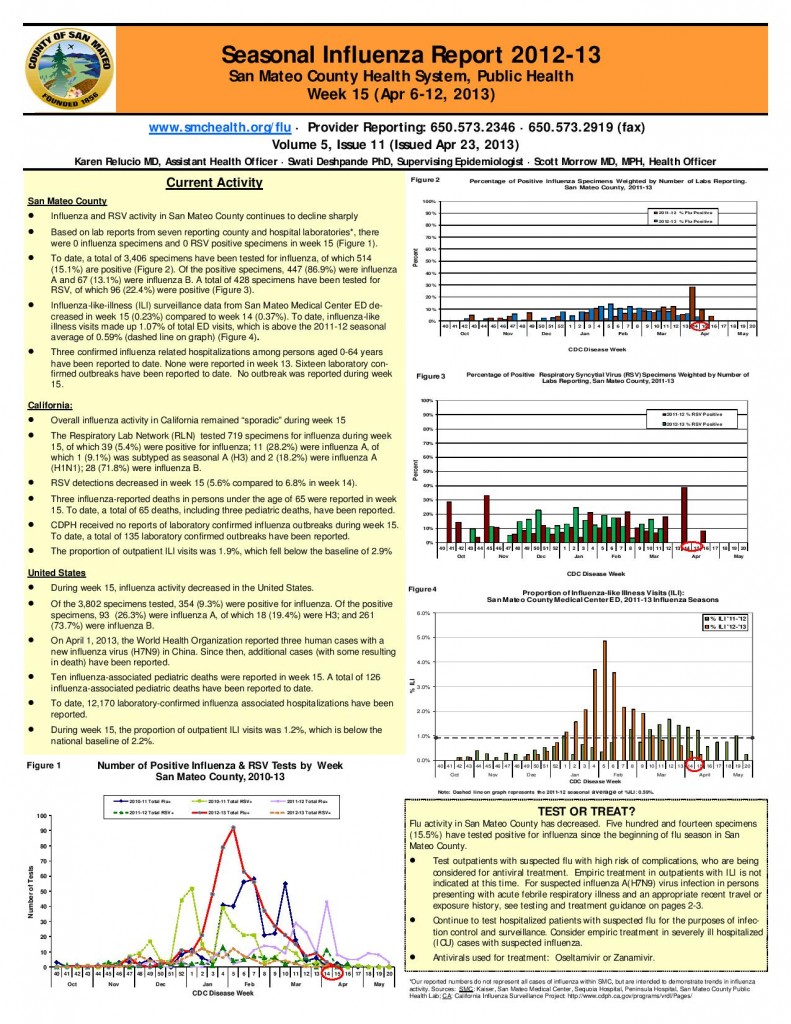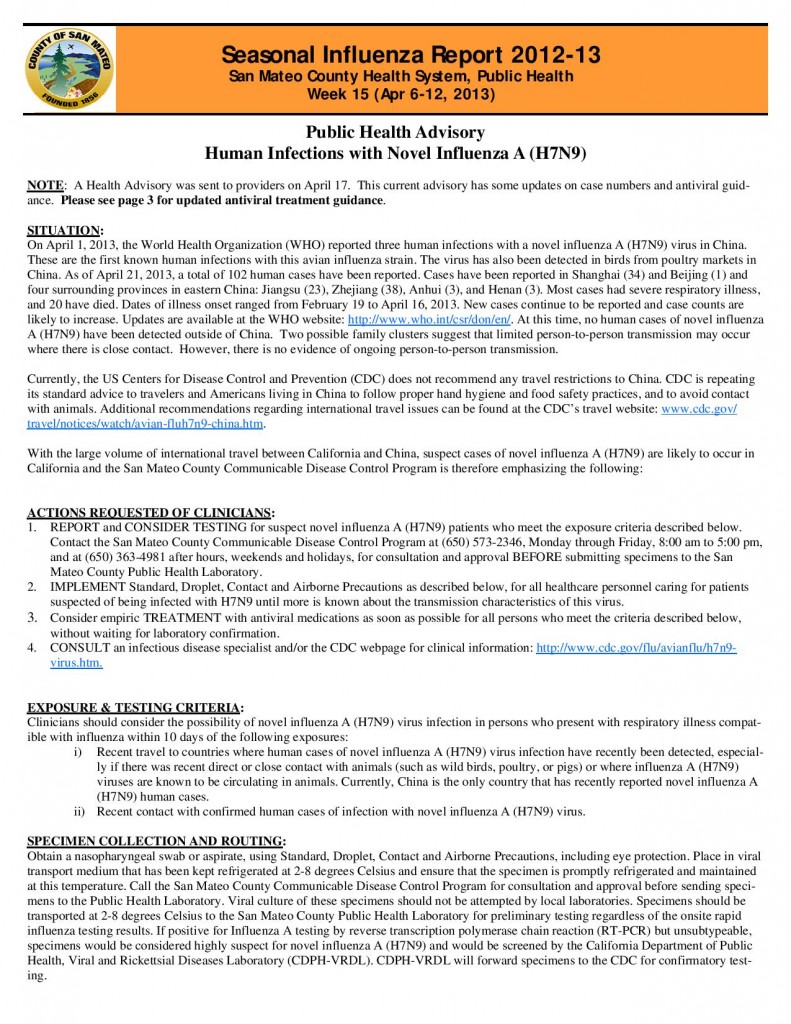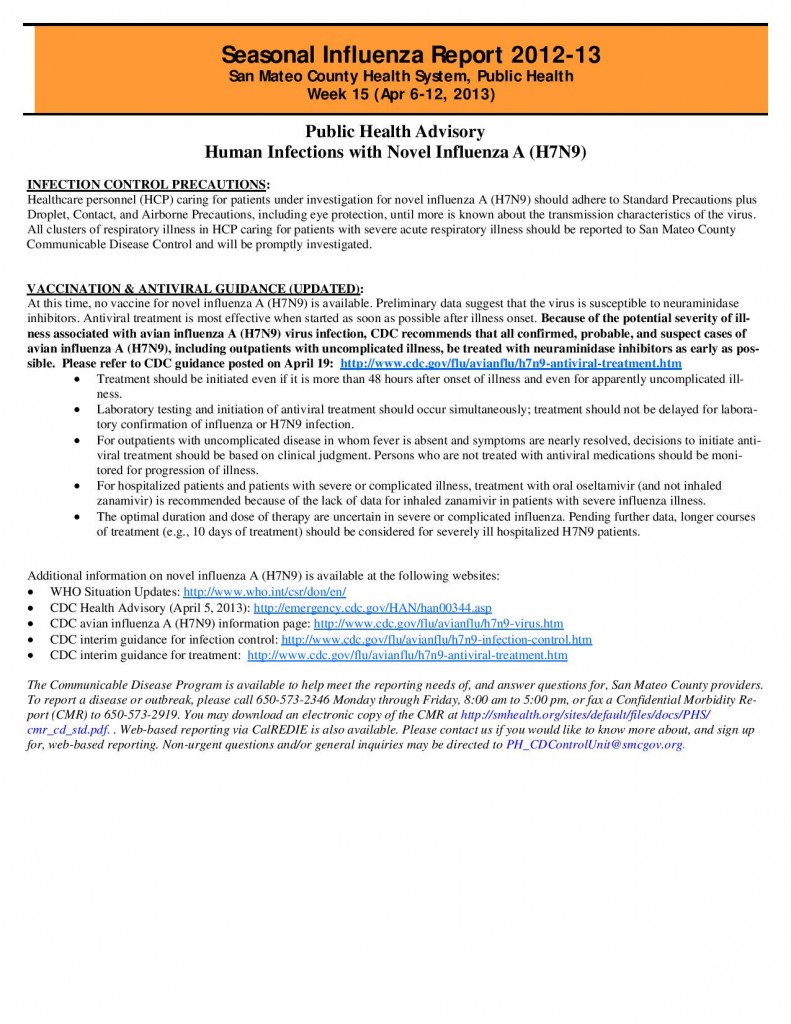Public Health Advisory Human Infections with Novel Influenza A (H7N9)
Seasonal Influenza Report 2012-13 San Mateo County Health System, Public Health Week 15 (Apr 6-12, 2013)SITUATION:
On April 1, 2013, the World Health Organization (WHO) reported three human infections with a novel influenza A (H7N9) virus in China.
These are the first known human infections with this avian influenza strain. The virus has also been detected in birds from poultry markets in China. As of April 21, 2013, a total of 102 human cases have been reported. Cases have been reported in Shanghai (34) and Beijing (1) and four surrounding provinces in eastern China: Jiangsu (23), Zhejiang (38), Anhui (3), and Henan (3). Most cases had severe respiratory illness, and 20 have died. Dates of illness onset ranged from February 19 to April 16, 2013. New cases continue to be reported and case
counts are likely to increase. Updates are available at the WHO website: http://www.who.int/csr/don/en/
At this time, no human cases of novel influenza A (H7N9) have been detected outside of China. Two possible family clusters suggest that limited person-to-person transmission may occur where there is close contact. However, there is no evidence of ongoing person-to-person transmission.
Currently, the US Centers for Disase Control and Prevention (CDC) does not recommend any travel restrictions to China. CDC is repeating its standard advice to travelers and Americans living in China to follow proper hand hygiene and food safety practices, and to
avoid contact with animals. Additional recommendations regarding international travel issues can be found at the CDC’s travel website: www.cdc.gov/travel/notices/watch/avian-fluh7n9-china.htm
With the large volume of international travel between California and China, suspect cases of novel influenza A (H7N9) are likely to occur in California and the San Mateo County Communicable Disease Control Program is therefore emphasizing the following information identified on these forms below.
(The CDC- Centers for Disease Control and Prevention) has also put out the latest reports stating the same and can be accessed HERE)




OP-ED: Better response to bird flu
April 29, 2013, 05:00 AM The Japan Times, Tokyo (via SMDJ)
Anew strain of bird flu has surfaced in China and it has health officials alarmed. While the death toll has reached double digits, the real cause of concern is the fact that it was previously not known to affect humans. Health officials in China and elsewhere are closely monitoring hospitals and clinics, as well as the close contacts of confirmed cases.
Surveillance is critical, not only of people, but also of poultry to trace the source of the outbreak and identify its vectors, as well as isolate the strain and prepare a vaccine.
The new flu comes from the H7N9 virus, a variant that has long been in pigeons but has never been found in humans.
Several had visited poultry markets before they got sick, but the actual source of the infection remains uncertain. Chinese experts believe that the virus originated in migratory birds that mixed with domestic fowl in China’s heavily populated Yangtze River delta.
As a result, many bird markets in eastern China have been shut down and culls are under way. Shanghai has banned the sale of all live poultry. It was reported Tuesday that the virus was detected in a wild pigeon caught in Nanjing.
Officials are also monitoring the close contacts of confirmed patients to ensure that they are not carrying the disease. …
Many questions still swirl around the outbreak, not least of which is its extent. China seems to be responding quickly to the appearance of the disease, with health officials stepping up surveillance and sharing results with international counterparts. Four of the viruses have been sequenced and posted on websites for international scrutiny.
People’s Daily, the mouthpiece of the Chinese Communist Party’s Central Committee, has called on officials to publicize information to avoid panic. In Shanghai a microblog is providing real-time updates. Daily email updates are also being sent.
China should be applauded for its about-face in responding to this outbreak, but the test is not over. The challenges will intensify if the disease spreads. China should be encouraged to maintain its transparency and its neighbors, along with relevant international institutions, should be vigilant and prepared to cooperate to contain, control and ultimately defeat this disease.